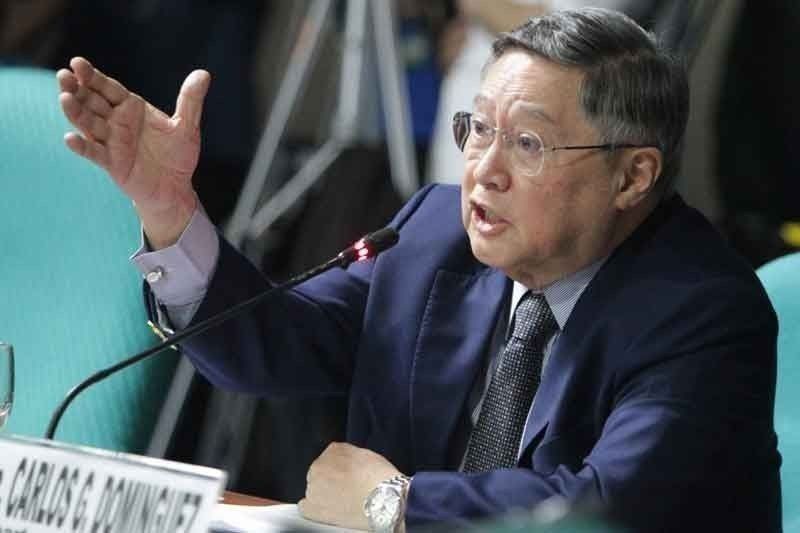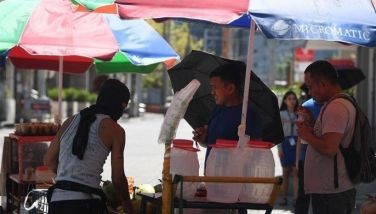Government COVID strategy placed at P1.74 trillion

MANILA, Philippines — The government will need a bigger amount – P1.74 trillion from an earlier estimate of P1.45 trillion – to carry out its “four pillar strategy” for jumpstarting the economy and addressing the needs of sectors most affected by the coronavirus disease 2019 (COVID-19) pandemic.
“The strategy has a combined value of P1.74 trillion or 9.1 percent of GDP (gross domestic product),” said Finance Secretary Carlos Dominguez III in a presentation yesterday to senators.
He said the first pillar involves emergency subsidies to vulnerable sectors, at P595.62 billion from last April’s original estimate of P583.81 billion.
The amount includes the P205-billion social amelioration program (SAP) of the Department of Social Welfare and Development, as well as the P51-billion Small Business Wage Subsidy program.
“Other relief programs for small businesses have also been put in place. The Philippine Guarantee Corp. board has approved the credit guarantee program amounting to P120 billion worth of loans to enable small business owners to borrow from banks during a crisis,” Dominguez said.
“We have also included in Package 2 of the tax reform program an expanded net operating loss carryover for five years amounting to P139.6 billion so that businesses can use losses incurred in 2020 to lower their tax burden until 2025,” he added.
Department of Finance (DOF) data showed that the budget for the second pillar of the strategy, which covers funding for medical resources to fight COVID-19, has also been raised to P58.63 billion from P35.72 billion.
“The third pillar consists of bold fiscal and monetary actions to finance emergency initiatives and to keep the economy afloat,” Dominguez said.
This package is expected to yield P1.089 trillion, which includes P436.93 billion in projected Official Development Assistance from multilateral agencies and bilateral partners, and P233 billion in additional liquidity through actions implemented by the Bangko Sentral ng Pilipinas.
Lastly, he said the fourth pillar involves an economic recovery program aimed at jumpstarting economic activity and providing industries with much needed assistance.
The DOF chief said the fourth pillar – estimated to cost P846 billion – will be funded largely through initiatives cited in the third pillar.
According to the DOF, the fourth pillar covers the proposed Bayanihan II bill, as well as the Corporate Recovery and Tax Incentives for Enterprises Act (CREATE), a recalibrated version of the Corporate Income Tax and Incentives Rationalization Act (CITIRA), which have a combined total of P173 billion.
Dominguez said the CREATE bill, in particular, is envisioned to be “one of the largest economic stimulus measures in the country’s history.”
The bill proposes the immediate cut in the corporate income tax rate from 30 percent to 25 percent starting July.
“The rate of reduction will free up almost P42 billion in the second half of 2020 alone, and more than P625 billion over the succeeding five years to fuel economic dynamism, especially among our country’s growth engines, the micro, small and medium enterprises,” Dominguez said.
He said the bill also proposes for the corporate income tax to be reduced further by one percentage point per year starting 2023 until it reaches 20 percent in 2027.
“We also extended by two years the sunset provision for those under the gross income earned regime from two to seven years in the current draft to four to nine years,” he said.
As the country prepares for the “new normal,” the National Economic and Development Authority (NEDA) will work with local government units (LGUs) to craft regional recovery programs, President Duterte said in his eighth report to Congress.
The President said the regional recovery programs would clearly define the role of LGUs in the recovery process and provide a description of their activities under each sector.
“The NEDA Regional Development Group directed all NEDA regional offices to engage LGUs, particularly those represented in regional development councils, to formulate regional recovery programs for their respective jurisdictions,” Duterte said in his report.
“The approach shall be bottom-up, responsive to the needs of the community,” he added.
Duterte said the technical working group on anticipatory forward planning led by NEDA would engage the Senate’s committee on sustainable development goals to propose bills for the new normal.
“As the country prepares for the ‘new normal’ scenario, the national government has implemented strategies not just to pump prime the economy but also to assist sectors in coping with this challenging transition,” the President said.
Duterte said NEDA is finalizing the working discussion paper “We Recover as One” on the proposed social, economic and governance strategies to enable the country to adapt to the new normal. The paper will also contain initiatives to rebuild consumer and business confidence.
“The NEDA is also spearheading discussions on formulating an economic recovery program to cover the period after the lifting of the community quarantine until the end of 2020 as well as an economic resiliency plan to be implemented in 2021,” the President said.
Meanwhile, Senate President Pro Tempore Ralph Recto said government’s economic stimulus package “should be as big and as bold” as the problem it is addressing, as “any piecemeal approach will just be wasting money without achieving the desired goals.”
Recto said he understands apprehensions against a package “with a large budgetary footprint, more so if it will be funded in part by loans.”
“But if the economy has flat-lined, then we should not be scrimping on the voltage needed to shock it back to life,” he said.
He maintained there are two emerging schools of thought in the government on how to fight the pandemic, revive the economy and transition to the new normal.
One is conservative in funding and with a short spending period, while the other is an omnibus package, multiyear in disbursement and premised on a worst-case scenario, like the absence of a vaccine, he said.
He prefers the second approach in reviving and protecting the economy like a medicine cabinet “where everything is there or one arsenal of responses, not piecemeal.”
He said a “one-time, big-time” pandemic response and resiliency package will spare both Malacañang and Congress from “episodic and seasonal” passage of laws authorizing new rounds of spending.
He said a stimulus package should be at least P1 trillion, as “you don’t use a fire extinguisher to fight a forest fire.”
“The response-recovery-resilience template is only as good as the funds that will be put into it. If joblessness has shot through the roof, if we have lost trillions in economic output, you cannot just apply a small putty to repair a cratered economy,” Recto said.
He said it does not mean that if Congress passes a P1-trillion economic stimulus law, the government would have to spend all of it.
“In the end, the President will have to decide when to push the spending trigger, based on the law,” Recto said. Paolo Romero, Alexis Romero
- Latest
- Trending



























